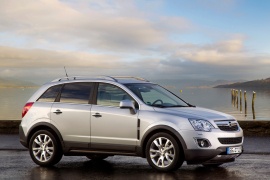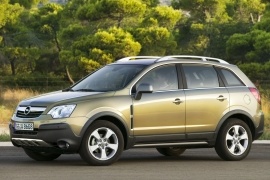OPEL Antara Models/Series Timeline, Specifications & Photos
First production year: 2007
Engines: Diesel, Gasoline
Body style: SUV (Sports Utility Vehicle)
In late 2010, Opel finally managed to introduce a facelifted version for the Antara, an SUV that was supposed to be a money-maker for the then-European arm of GM.
With the financial crisis already gone, the market started to recover. Opel, on the other hand, was in dire financial shape. Still, it tried to recover and improve its SUV in a market that shifted from minivans to these kinds of vehicles. The idea was great, and the German brand had a good starting point. And yet, it didn't make it.
One of the most important changes was on the front fascia, where the Antara received new angular headlights. They matched the chromed double-slat mounted on the grille between them. In addition, a pair of foglights surrounded by chromed trims found its way on the lower bumper, while the door mirrors received new blinkers. At the back, there was a new design for the taillights in the rear and repositioned reversing lights.
Inside, the Antara offered five seats as standard, and the carmaker noticed that customers were not very excited about the seven-seat version, so it dropped it. However, it focused on the dashboard, which featured a new design, with lines carried over from its compact sibling, the Astra. Moreover, a new infotainment unit with a screen placed atop the center stack made its way into the Antara options list.
Opel already switched to Euro 5 emission standards, so the Antara got only these types of engines, either gasoline or turbo-diesel. The former 3.2-liter V6 was cut from the options list, and thus the most potent version remained a 2.2-liter turbocharged oil-burner that provided 181 hp (184 PS).
Sharing most of its underpinnings and powertrains with the Chevrolet Captiva, the Opel Antara was a compact crossover SUV designed by the German carmaker between 2006 and 2015.
Built on the Theta platform, the Antara offered seating for 5, while the Chevrolet Captiva could accommodate up to 7 occupants.
The model was sold under different names depending on the market, such as Vauxhall Antara in the UK, Holden Captiva MaXX in the Australasia and as Saturn Due in Canada and the US.
Resembling the Opel Antara GTC Concept presented in 2005 at the Frankfurt Motor Show, the final version featured a stylish exterior design with a sporty and athletic look.
Inside, the driver-oriented cockpit was practical and looked well, with its design getting close to that of a more luxurious sedan. Other eye-catching details inside the cabin were three large round air vents and a distinctively shaped handbrake grip.
Space-wise, the new Antara offered a roomy cabin with great legroom and headroom for all occupants. The trunk was a good size offering a transport volume of 370 liters, 865 liters with the folded bench and up to 1420 liters when loaded to the roof.
Safety was also considered with fron and side airbags, head curtain airbags, three-point seat belts and head restraints, as well as belt-face limiters and seat-belt pre-tensioners.
The Opel Antara was available in three trim levels: base, Antara Edition, Antara Cosmo. Even with the base trim level, the Antara was well equipped with fog lamps and halogen headlamps, air-conditioning, power heated exterior mirrors, Board Info Display, front and rear power windows, a collapsible rear bench and lots of storage spaces and nets on the center console and on the back of the front seats.
With the upper trim level Edition, the Antara was equipped with added 17-inch alloys, a leather steering wheel and gear knob, heated fron seats, a center armrest, Automatic Lighting Control and Trailer Stability Assist.
The top-of-the-range added bigger 18-inch alloys, leather upholstery, cruise control, Park Pilot, rain sensor, door sills and others.

